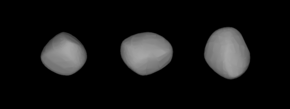 A three-dimensional model of 679 Pax based on its light curve | |
| Discovery | |
|---|---|
| Discovered by | August Kopff |
| Discovery site | Heidelberg |
| Discovery date | 28 January 1909 |
| Designations | |
| (679) Pax | |
| Pronunciation | /ˈpæks/[1] |
| 1909 FY | |
| Orbital characteristics[2] | |
| Epoch 31 July 2016 (JD 2457600.5) | |
| Uncertainty parameter 0 | |
| Observation arc | 106.90 yr (39044 d) |
| Aphelion | 3.3910 AU (507.29 Gm) |
| Perihelion | 1.7808 AU (266.40 Gm) |
| 2.5859 AU (386.85 Gm) | |
| Eccentricity | 0.31135 |
| 4.16 yr (1518.8 d) | |
| 33.4022° | |
| 0° 14m 13.272s / day | |
| Inclination | 24.387° |
| 112.263° | |
| 266.736° | |
| Physical characteristics | |
| 25.735±1.2 km[2] 32.44 ± 1.82 km[3] | |
| Mass | (7.14 ± 1.99) × 1017 kg[3] |
Mean density | 4.99 ± 1.62 g/cm3[3] |
| 8.452 h (0.3522 d) | |
| 0.1660±0.017 | |
| 9.01 | |
679 Pax is a minor planet orbiting the Sun that was discovered by German astronomer August Kopff on January 28, 1909. It is named after Pax, a Roman goddess. It is orbiting the Sun with a period of 4.16 years and an eccentricity of 0.31.
Measurements using the adaptive optics at the W. M. Keck Observatory give a mean diameter of 62 km. This is 16% larger than the diameter estimated using the IRAS observatory. The asteroid is elongated with a size ratio of 1.66 ± 0.23 between the major and minor axes. Photometric measurements reported in 1982 gave a rotation period of 8.452 hours.[4] The asteroid's pole of rotation lies 32° away from the plane of the ecliptic.[5]
Polarimetric study of this asteroid reveals anomalous properties that suggests the regolith consists of a mixture of low and high albedo material. This may have been caused by fragmentation of an asteroid substrate with the spectral properties of CO3/CV3 carbonaceous chondrites.[6]
- ^ "Pax". Oxford English Dictionary (Online ed.). Oxford University Press. (Subscription or participating institution membership required.)
- ^ a b Cite error: The named reference
JPLwas invoked but never defined (see the help page). - ^ a b c Cite error: The named reference
Carry2012was invoked but never defined (see the help page). - ^ Cite error: The named reference
Marchis2006was invoked but never defined (see the help page). - ^ Cite error: The named reference
Marciniak2011was invoked but never defined (see the help page). - ^ Cite error: The named reference
GilHutton2008was invoked but never defined (see the help page).